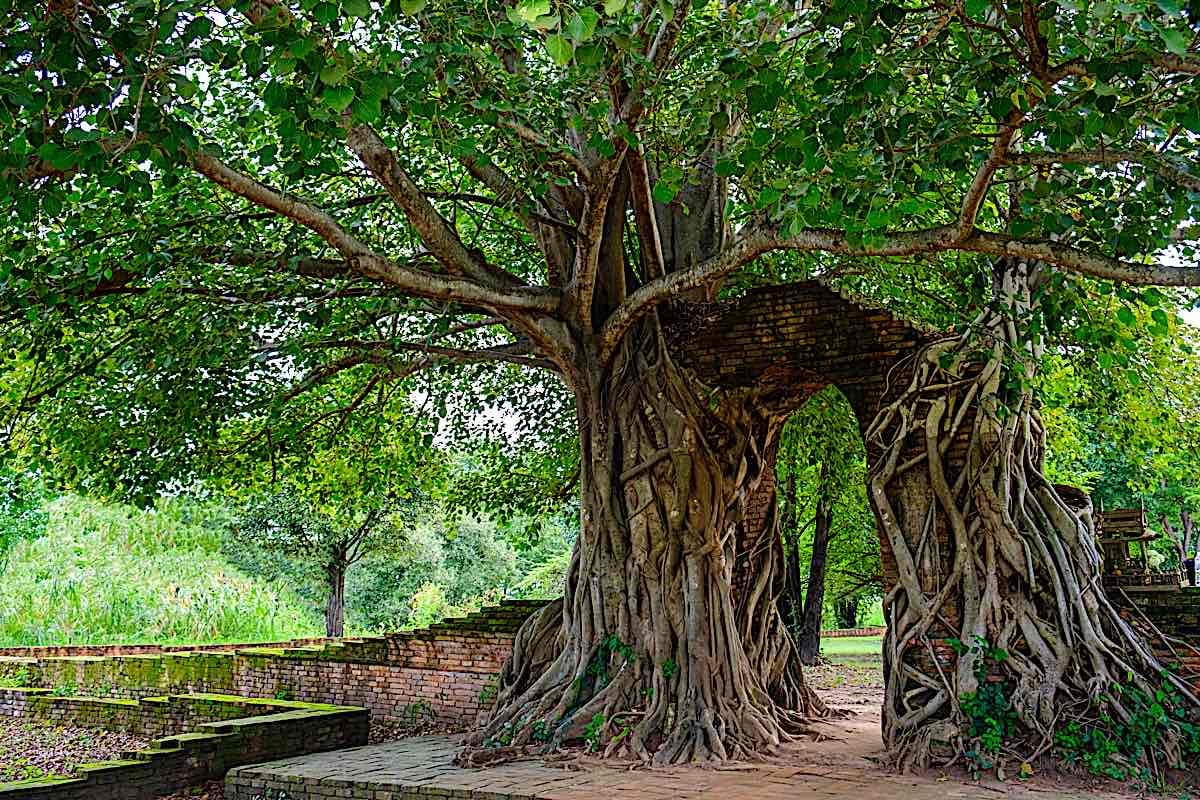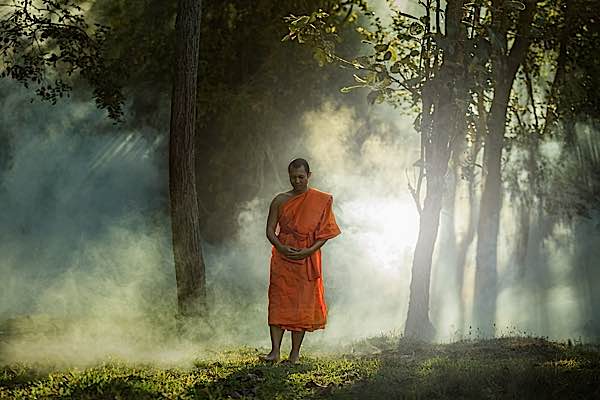What Does Buddhist Sutra Say About Sustainability?
The world may still be way behind its Paris 15 goals for greater sustainability, but the good news is that big strides are being made. Research indicates that consumers are more concerned about sustainability than in previous years and sustainable...

 Nature and trees have always been important in Buddhism. This sacred Bodhi tree, the Gate of Time in Thailand, is a Bodhi Tree that grew into the shape of gate at Wat Phra Ngam Phra Nakhon Si Ayutthawa. Bodhi Trees are especially sacred to Buddhists because Buddha sat under the Bodhi Tree to meditate, determined to stay in that spot until he was Enlightened. After his Enlightenment, he remained in the jungles and forests, meditating and teaching with his monks.
Nature and trees have always been important in Buddhism. This sacred Bodhi tree, the Gate of Time in Thailand, is a Bodhi Tree that grew into the shape of gate at Wat Phra Ngam Phra Nakhon Si Ayutthawa. Bodhi Trees are especially sacred to Buddhists because Buddha sat under the Bodhi Tree to meditate, determined to stay in that spot until he was Enlightened. After his Enlightenment, he remained in the jungles and forests, meditating and teaching with his monks.The world may still be way behind its Paris 15 goals for greater sustainability, but the good news is that big strides are being made. Research indicates that consumers are more concerned about sustainability than in previous years and sustainable products enjoying a 32% of growth.
Our faith and values can play an important role in going beyond purchasing eco-friendly products and waiting for governments to play a more active role in saving the Planet.
By Karoline Gore
Indeed, ahimsa, or non-harming, is a central tenet of Buddhist ethics. Far from merely espousing the need for kindness to all human beings, it can also be interpreted as a call to protect the natural world and the animals that call it home.
Buddhist’s can learn from numerous Buddhist texts to find inspiration to help lead a greener, more environmentally responsible life, starting today.
The Dhammapada
The Dhammapada, a collection of sayings attributed to Buddha, emphasizes qualities that align strongly with sustainability. It prioritizes values like compassion for all sentient things and mindfulness of one’s actions and their consequences. When we make conscious decisions to protect the planet—for instance, by refusing to buy palm oil products to save the precious orangutans that live in rainforest habitats where palm trees abound—we show our compassion.
 A Buddhist monk performing formal walking meditation on a forest path. Buddhist monks traditionally have always meditated and retreated to forests and wild places.
A Buddhist monk performing formal walking meditation on a forest path. Buddhist monks traditionally have always meditated and retreated to forests and wild places.
Sustainability is also about making mindful choices for everything from the food we buy to the way we move around and the vehicles we purchase. Currently, many people are making the switch from fuel-based to electric cars that do the job without destroying our air quality. When making a big decision such as this, it is important to do your research not only into your vehicle’s functionality but also into matters such as whether it has vegan interiors instead of animal-derived ones like leather.
 Buddhists have always meditated in forests and wilderness and caves. When Buddha sat under the Bodhi Tree to meditate, he called on the Mother Earth as his witness. She symbolically arises to sweep away the Mara’s in a flood in this early story reflecting the importance of the earth in Buddhism.
Buddhists have always meditated in forests and wilderness and caves. When Buddha sat under the Bodhi Tree to meditate, he called on the Mother Earth as his witness. She symbolically arises to sweep away the Mara’s in a flood in this early story reflecting the importance of the earth in Buddhism.
Mindfulness Sutras
Numerous mindfulness sutras, such as the Satipatthana Sutta, inspire Buddhists to be aware of the impact of their actions and to reduce their greed and attachment. Unfortunately, much of the current problem of global warming is caused by excessive greed and the prioritization of profits over the long-term survival of the planet.
The good news is that consumers have spoken, and the companies that provide them with products and services are listening. Research shows, for instance, that some 80% of people are willing to pay more for sustainably produced or sourced goods. This means that being sustainable while still obtaining what you need to survive is more possible than it ever has been. In the Metta Sutta, meanwhile, Buddha encourages the practice of metta (loving kindness) toward all beings. The scripture reads, “Let one radiate boundless love towards the entire world—above, below, and across—unhindered, without ill-will, without enmity.”
 Rukkhadhamma Jataka tells the story of Buddha as a tree spirit in his previous lives.
Rukkhadhamma Jataka tells the story of Buddha as a tree spirit in his previous lives.
The Jataka Tales
If you are the type of person who finds inspiration in stories, then you may be interested in reading the Jatakas or birth stories of Buddha. There are some 500 Jataka Tales, which center on the past incarnations of Buddha. In the stories, Buddha often appears as an animal or tree, teaching values such as self-sacrifice, compassion for those in need, and benevolence toward the natural world.
In the Rukkhadhamma Jataka, for instance, Buddha highlights the importance of heeding the lessons of the forest and witnessing the inexorable link that binds all life.
In this story, the Bodhisattva is born as a mighty tree spirit, who guards a tall, sturdy tress in a forest. Nearby is another tree spirit, which guards a smaller tree. One day, a fierce storm approaches, and the smaller tree asks the Bodhisattva for help. The Bodhisattva explains that strength comes together… that if they stand united, their roots and branches will support each other and they will survive the storm. However, if they become divided, then the wind can easily uproot them. By emphasizing connection, the Bodhisattva reveals to which our own well-being depends on how we treat the environment.
 “The person who clings to nothing of the past, present and future, who has no attachment and holds on to nothing — that person, I call a Holy Person.” — The Buddha, Dhammapada 421
“The person who clings to nothing of the past, present and future, who has no attachment and holds on to nothing — that person, I call a Holy Person.” — The Buddha, Dhammapada 421
If you wish to lead a more sustainable life, you will find a host of inspiration in the Dhammapada, mindfulness sutras, and the Jataka Tales. However, there are many more texts and scriptures that highlight the many reasons why our Planet is worth fighting for. As a parting thought, consider the Samyutta Nikaya, which contains the following phrase: “Those who plant gardens and forests, who build bridges, who set up places for water to be drunk and wells or those who give dwelling places, for them merit always increases.”

 Aliver
Aliver 































